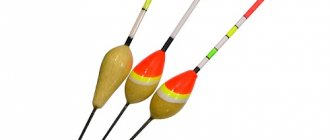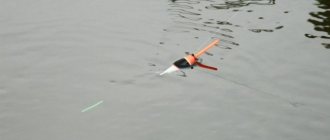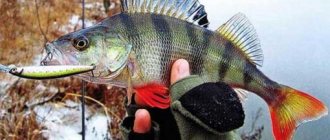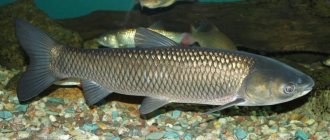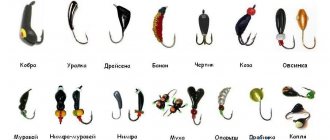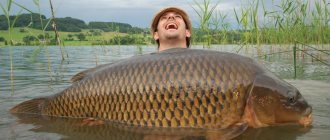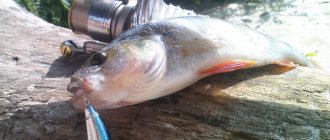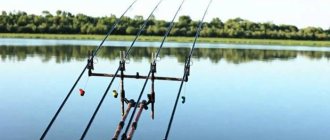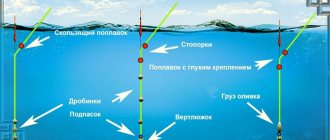For fans of baitless fishing, reelless jigs are the last piece of gear that directly forces the fish to grab the hook. There are no bloodworms on a reelless bait, and the success of fishing depends on the correct choice of jig, as well as attractive play with bait. In this article we will look at the most catchy baitless jigs, features and nuances of use.
Fishing with reelless jigs
Beginners often make the mistake of starting their journey in baitless fishing by chasing the “most efficient” and most catchy jig. The main thing in winter fishing with jigs without moths is to adhere to the basic principles, which differ from standard fishing with the addition of bloodworms. To begin with, you master the correct game using standard jigs, and understand the characteristics of the tackle and fish bite. Read more about this in a special article:
Fishing without a bait in a current differs from fishing in still water; different tactics are used on a reservoir than on a small river. The equipment of a fishing rod is specific, and the wrong approach to this issue is unlikely to bring a bite. An article about winter reelless fishing rods. Only after understanding the basics and mastering a few simple baitless jigs for winter fishing should an angler dive deeper into the vast world of these lures. You can only find the best reelless bait by acquiring fishing experience on a pond. There is not a single universal model - only in certain fishing conditions, for a specific type of fish and using the right game.
The main law of no-bait is a balanced rig, matching line, nod and reel, as well as monotonous play without failures. These features and nuances are discussed in detail using the links provided. In this article we will look at what a reelless jig is and what types of nozzle jigs there are.
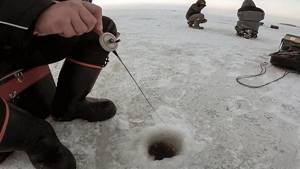
How to choose the time and place for winter fishing for reelless?
For successful fishing with baitless baits, it is very important to choose the right time and place of fishing:
- With constant or slightly changing atmospheric pressure and weather over several days, the bite on a reelless jig is most active during the day in the morning (from 8 to 10) and evening (from 15 to 16-17.00).
- The most promising places throughout the winter fishing season for the angler without a moth are various anomalies of the bottom topography (pits, mounds), flooded snags, bushes, shallow areas bordering the depths, dumps and edges of holes, windows in coastal reed thickets.
Note! You can find the most promising fish accumulation points in an unfamiliar body of water using a winter echo sounder.
What kind of fish should I catch in winter using a reelless bait?
The following types of fish are caught using a reelless bait:
- Perch;
- Ruff;
- Gudgeon;
- Roach;
- Guster;
- Bream;
- Zander;
- Pike.
Also, in some stagnant reservoirs, large crucian carp and carp can be caught with a reelless bait.
Reelless jigs
Nozzle-less jigs are a generalized category. If you hang a bead on the hook of an ordinary jig instead of a bloodworm, the bait turns into a baitless one. However, this difference is deeper than at first glance. The best reelers, when approached correctly, seduce fish that are not feeding at the moment, forcing them to bite out of curiosity. Therefore, the no-bait fisherman counts on a catch when standard gear with bait is silent. There are an endless variety of varieties, types and species of mothless moths. Every year new ones appear, offered by fishing stores or made by amateur home-made workers.
For professionals, nozzle is an exciting sporting activity. These fishermen go out to the reservoir not with the goal of catching fish, but for the sake of biting on artificial pieces of iron. In amateur fishing, baitless fishing is rather one of the methods that organically complements the entire range of fishing methods. When fishing for bream with devils, for example, it would not be amiss to attach a bunch of bloodworms to the hook after the fish approaches the point, and a non-moth gear can be used for searching or teasing.

Specifics of reelless jigs
Let's look at the difference between attachment jigs and no-reel jigs. The main difference is the purpose of application. With the addition of bloodworms, the task of the bait is to load the bait and nod, and deliver the equipment to the bottom. The biting factor is live bloodworm larvae on a hook. Therefore, color and appearance are secondary. Standard jigs often form a simple vertical suspension when tied to a fishing line, with the hook pointing down. For baitless baits, baits with a horizontal or angular suspension are more suitable, since the fish tries to grab not the hook itself, but the entire jig, perceiving the bait as a single object. A hook deflected to the side increases the likelihood of a successful hook. Different types of mothless moths are characterized by different suspension angles. The subtleties of the behavior of decoys underwater when playing depend on this parameter.
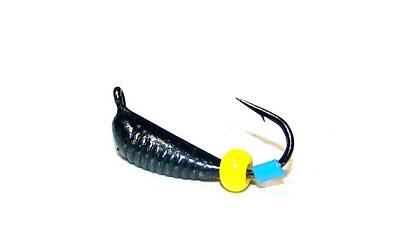
Hooks in baitless fishing are equipped with various additional elements - beads, balls, threads. Often the factor of bead color or contrast becomes decisive on a pond. At the same time, a number of jigs (for example, devils) are sometimes used without pendants at all. The features of reelless jigs depend on proper play. No matter how bright or beautiful the piece of iron is, the fish will not take it if it is wired incorrectly. The correct game is the basis of baitless fishing, and the equipment of a reelless fishing rod is secondary; working options are revealed already during the fishing process.
The Internet is full of ratings of reelless jigs. These are the machinations of marketing or advertising. You won't find the top 10 mothless fish here - it doesn't exist for fish. Each lure can be the best reelless bait for winter fishing, but only in certain hands, in certain conditions on the pond and with the right game. Let's look at what types of reelless jigs there are and the conditions for their use.
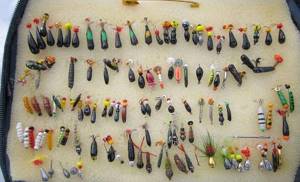
Working rewinders
How to distinguish a reelless jig from a simple jig? The simplest thing is the presence of bright artificial elements on the hook. For the first experiments, you don’t need to buy specialized reelless jigs; standard pellets, droplets, and oats will do. It is better to choose baits with a suspension to the line close to 45 degrees, and equip the hook with a pair of contrasting beads - white and black, green and red, etc. Small beads with a large hole (to fit through the beard of the hook) are more suitable. To prevent the beads from falling off, a cambric or piece of plastic is threaded through the top. An example is a Cyclops jig, essentially an ordinary washer (tablet), just an artificial eye was glued to the front surface and decorations were hung on the hook. Let's consider the working popular options for mothless machines.
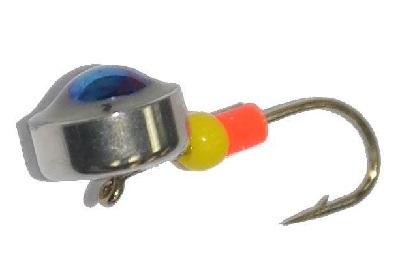
Cyclops
Sausage
Mormyshka sausage is made from a metal rod cut according to the castmaster principle. Unfortunately, you rarely find this wonderful breamless reeler in the store. Fishermen often make it themselves. The sausage is distinguished by a game similar to vertical spoons - when released, it sinks, deviating a step to the side and returning to its place (due to the angular surfaces of the cuts). Application – catching bream at depth or perch using the micro-spinner principle (reelless baits cut short, but with large angles, closer to the castmaster, are suitable for this).
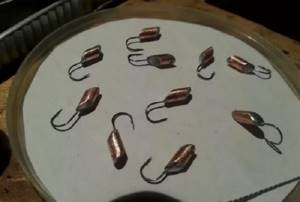
Long cut sausage
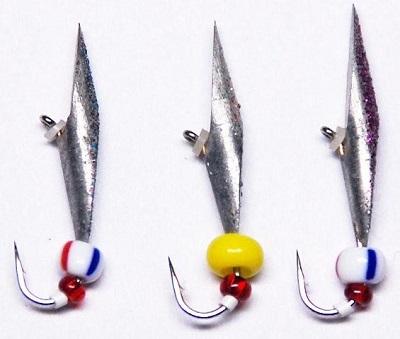
Short cut
Dreissen
The zebra mussel jig is shaped like a shell of the same name, which is a natural food for bream and large roach. This is a fairly large and heavy rewinder that penetrates the water layer well. Has a nodding action (due to its low center of gravity), causing the ornament hook to tilt up and down.
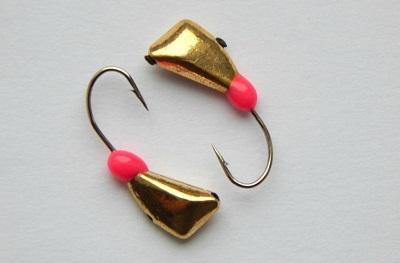
Dreissen
Owl
A large nozzle-less owl jig (formerly called a scoop) is more of a micro-spoon. Excellent for baitless fishing for bass, perch or pike perch. During periods of activity, it is taken by a large crucian carp or carp; this mothless fish mows down into a small fry. Thanks to its widened and curved shape, it glides and nods even at great depths.

Homemade owls
Ants, bugs and nymphs
The most popular class of mothless. These are elongated jigs with a slight bend throughout the body. Depending on the thickness, length and characteristics, they are called differently. They are positioned as resembling underwater insects from a distance. The ant has a thick head at the top, while the bug's center of gravity is in the middle (somewhat similar to the dracena). The nymph is more protruding and less arched. Each type has its own game, determined by the location of the center of gravity. An interesting option is the black widow jig, so named because of its unique coloring. This reelless jig consists of three ball joints, descending in size from the top of the jig to the hook. All these types of reelless baits are universal and catch any fish. There are hundreds of different options. A couple of nymphs and ants of different sizes and colors (such as black and silver) are a great start to learning to use wormless baits.
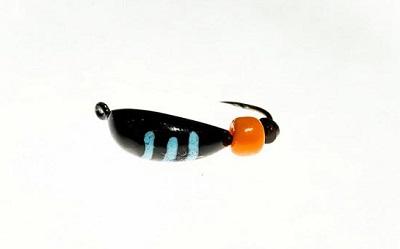
Nymph
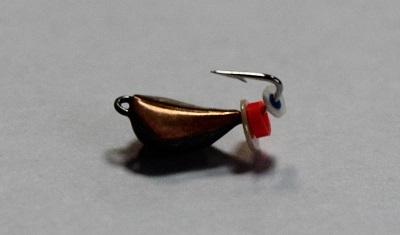
Klopik
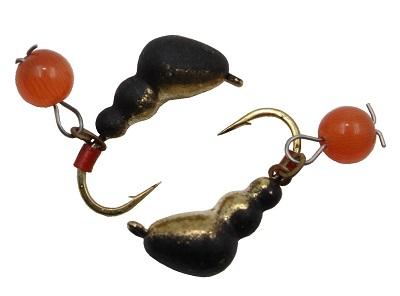
Ants
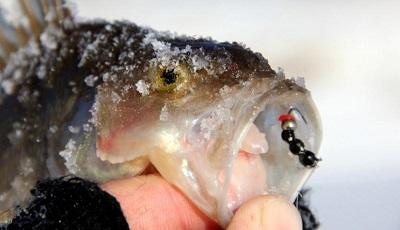
Black Widow
Goat
The peculiarity of this rewinder is the presence of two soldered hooks facing to the sides. This bait is similar in size to single-hook hooks. The mothless goat also comes in a variety of shapes and colors. The standard option is black or silver. Due to the special shape of the body, it sometimes works well without any decorations, resembling a fry in the silver version, and a beetle in the black version. Working reeler for active fish.
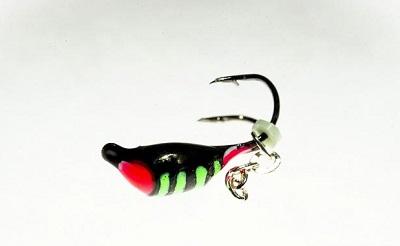
Goat
Banana
Bananas are slightly larger than nymphs. Roughly speaking, a banana jig is a large nymph. There are plenty of models, colors and weights. A universal rewinder that works in a variety of water bodies and conditions.
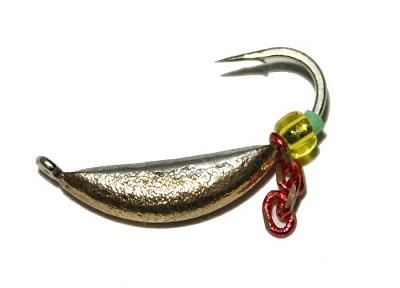
Banana
Cobra
Another type from a series of convex-bent non-rewinders for creating a planning game. The reelless cobra, depending on its size, catches any fish. As always, the key is to find the right game. Large cobras are used as micro-spoon baits.
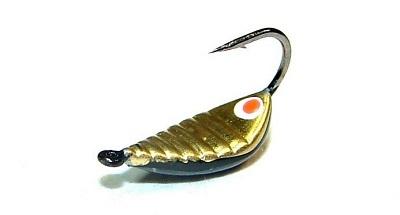
Cobra
Uralka
A classic jig with a long body and a thickened top, gently curving towards the hook. Small uralks are suitable for roach and bream; bream in the depths and perch in the shallows do not refuse large ones. The Uralka reelless bait is another excellent universal bait for a beginner.
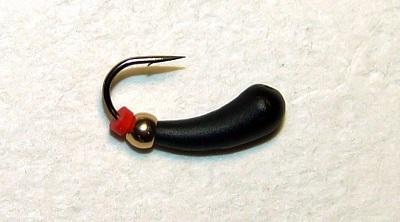
Uralochka
Cuttlefish
The cuttlefish is a hybrid of a cobra and a goat. The shape of the bait is similar to a cobra, and is equipped with two hooks, like a goat. Interesting model to study.
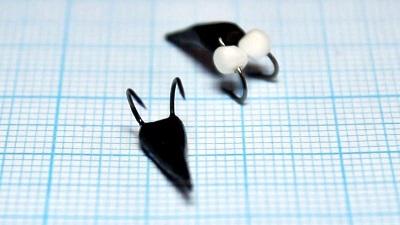
Cuttlefish
TOP best lures - baitless
If you don’t know what lures you need to buy first to try reelless fishing, pay attention to the models in this rating.
Pellet
One of the most popular jigs with a ball-shaped body. Quite versatile. Most often used for catching perch and roach.
A drop
A mothless fish with a teardrop-shaped body. The second most popular type of bait. As with the pellet, the main advantage of this bait is its versatility.
Uralka
Another catchable reeler, which has a body in the shape of a curved drop. Works well on basic mothless wiring.
Goat
This jig resembles the Uralka in body shape. Its main feature is a double, rather than single, hook.
Ant
The body of such a jig consists of 2, 3 or 4 segments that resemble the body segments of an ant.
Klopik
An interesting jig that was very popular several decades ago. It is carried out with slow, wide-amplitude movements. In terms of catchability, the bug is inferior to other modern jigs. But you can try it when standard baits do not produce results.
Devil
An original mothless fish, the body of which is located completely vertically in the water. A good bait for angling a wide variety of fish, in particular, bream and large perch are very fond of it.
Devils
It’s not for nothing that baitless jigs like devils and the like are loved by fishermen without reeling. When used skillfully, these baits become super catchy. They are quite heavy, so they are convenient for use at various depths, including currents. Some fishermen fish only with devils, not recognizing other baits. These are effective catchers for white fish and predators. Elongated devils work well on bream, round and pot-bellied ones work well on roach and perch. The main feature of the bait is its vertical weight balance.
When playing, the devil should not make parasitic horizontal oscillations; only up and down movements are permissible. The wiring animates the behavior of the amphipod bug in the water - uniform dotted movements. There are many varieties of such jigs - solid, composite, with a ring or hole through the body, with soldered hooks or hanging ones (devils, graders). The devil jig, in addition to its own movements, also chaotically throws a suspended tee when retrieving it, which works great for perch during the dry winter period.
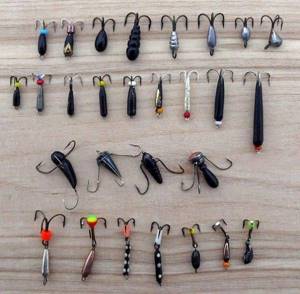
Catchable beads for catching bream in winter
A very important element of any baitless jig for bream is a set of beads mounted on the hook shank.
These, at first glance, completely stupid trinkets add a special flavor to any mothless item. It is thanks to the different color combinations of beads that the jig turns into a highly specialized bait.
If you attach beads with a combination of black and orange colors to the bend of the hook of the same bait, then the reelless bait turns into a perch bait, and it will be taken mainly by small stripers.
But if you change the beads to a white-blue combination, the bait becomes bream , and large white bream and full-sized bream will take on it.
If you don’t have beads of a suitable color on hand, then small cambrics from wire insulation, similar colors to the beads, will also work. The hook itself of a cool nozzle should not be too large and elongated.
Carnations (columns)
Once the simplest baits, which consisted of soldering hooks of various lengths, have now turned into catchy, reelless jigs. Reelless baits with a large ball element on the hook are becoming more and more popular. When playing, this element moves freely along the fore-end, creating its own micro-oscillations. In addition, such a ball taps on the bottom of the jig, which additionally attracts fish. The hit of recent seasons is the cat's eye jig, equipped with a large ball of a characteristic dark green color on the hook. It is believed that this mothless insect has a particularly lethal effect on roaches.
A class of such baits is called nail balls. Balls on hooks can be plastic, glass or metal, of various colors. They are placed on the hook by directly threading it through the sting or on a pendant. A similar bait is a nail cube. Instead of a ball, a large cube is placed on the hook, which, in addition to the above properties, gives micro-glares with its edges when playing. The main wiring includes elements of dribbling - with high-frequency play, the suspension on the hook works correctly.
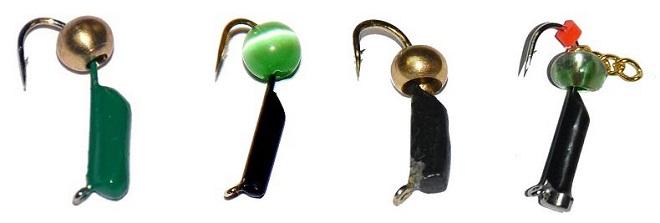
Nailballs
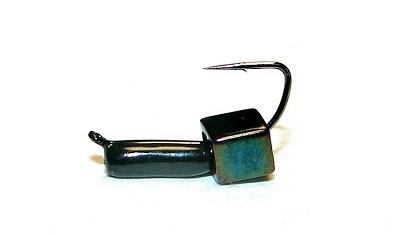
Clove cube
Mothless – don’t believe me? Don’t you believe the Moscow Art Theater pause?!
Now you need to very smoothly and fish.
Do the wiring not so much slowly as carefully. Very smooth, very rhythmic. The work occurs exclusively by nodding with the same amplitude.
This is exactly the test work on the copybooks in the final copy. Each reeler has his own special wiring, which, in his opinion, should work flawlessly on the fish.
Once upon a time, a long time ago, I didn’t know the alphabet, but I knew how to “draw” my name in block letters.
It seemed to me that LeshaK was quite enough to make my mother proud of me. And she, of course, was touched by my first skills.
Further more. I learned to “draw” my last name, which has many letters - KOLOMETS. My father laughed and said that because of the omission of one letter “I”, perhaps they would give me a salary, but it was unlikely that I would get a bonus.
Now I smile remembering it, and at the end of each climb I make the obligatory “IEC” nod.
Then a pause, as if, like an artist, I was admiring or appreciating the final touch. Then I clear the line of ice and start from a new line, that is, again from the very bottom.
Again smoothly, again rhythmically I draw my copybooks. I remember at what level from the eyes the fish “sniffed” the bait.
All eyes on the nod!
The slightest delay in the nod, and the relaxed hand of the right hand flies up.
In smooth wiring it is not necessary to strain your right hand, so what works for me is the left hand, which supports the relaxed hand of the right hand.
And again I draw letter by letter, bend by bend... No bite?
Or maybe he hasn’t added “IEC” yet? I finish writing... and again there is a pause.
The pause is longer than usual, because I haven’t yet figured out how to bait the bait next time - and the fish can’t stand it. The nod brazenly bends downwards, and the fish hangs on the elastic pole of the winter fishing rod.
This is applause, this is a reward. And it doesn’t matter anymore whether I’m an actor or a diligent student – the main thing is that the fish like it!
You might be interested in an article on the topic of reelless fishing
With a jig after a winter chub
Witch, idiot and the like
These baits are difficult to strictly classify as jigs. Large varieties reach a weight of several tens of grams and are used in winter lures. However, the smallest options fit perfectly into the rewinder. The main principle of the bulldozer is tapping on the bottom, raising clouds of turbidity, while the hooks with beads lag behind the heavy body and fall slowly. These factors make the Balda a killer bait for perch.
The nozzle-free jig is a smaller copy of a bait for trolling - a conical weight with a horizontal hole at the top, through which the bait is attached to the fishing line with a loop. Hooks with beads (flies) run freely in the loop. Read more in the article about winter fishing gear

Balda
The witch (aka jellyfish) works on the same principle, only the hooks are attached directly to the body of the bait, on special mounts.
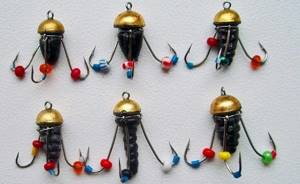
Witch (jellyfish)
The rotorcraft jig is a flat cake with a hanging tee. One of the new rewinderless products. All the possibilities have not yet been revealed, but its homemade inventors are not overjoyed with the result.
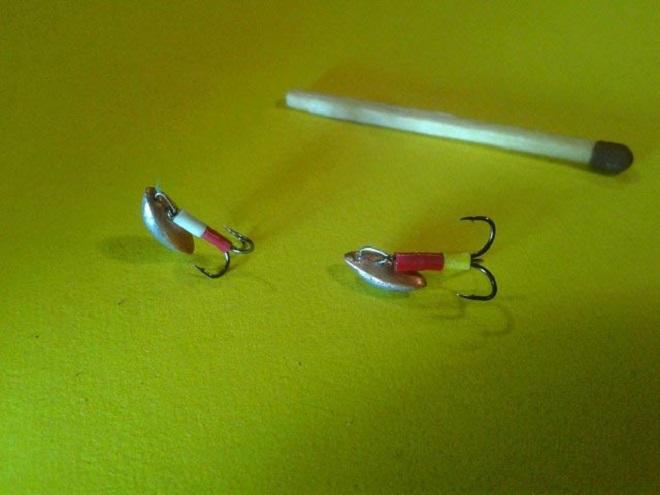
rotorcraft
The dragonfly jig is a type of witch, only equipped at the bottom of the weight with an additional hook, single or tee.
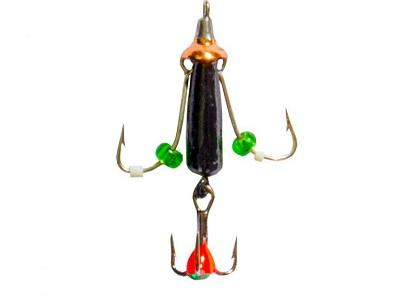
Dragonfly
The sharaga usually has 3-4 hard-soldered hooks; it is somewhat reminiscent of a devil, but still much more massive. The purpose is also tapping on the bottom and lifting. The game of such baits is specific - knock on the bottom, rise, pause. A specific feature of such jigs is that the fish often takes the entire bait (like a standard reelless bait), and attacks only the hooks with decorations. Such baits are mainly used for perch fishing. However, during periods of activity, white fish do not pass by them.
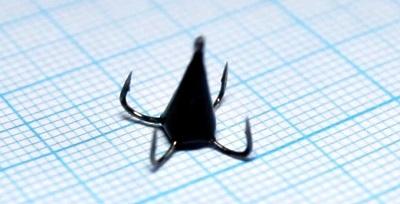
Sharaga
Equipment
Equipping a rewinder is a delicate process. The result should be a balanced tackle along the line jig - fishing line - nod - fishing rod (fisherman's hand). In reelless fishing, direct contact between the angler and the bait is important.
Reelless jigs
Rigging a fishing rod begins with choosing a jig, and not the other way around. The diameter of the fishing line and the nod are selected based on the weight of the reelless reel. The jig itself can be anything - from the point of view of equipment, the balance of all components is important. The rewindless jigs themselves are discussed in detail in a separate article:
fishing line
The rewinder uses line diameters from 0.06 to 0.14 mm. 0.06-0.08 mm is more often used by athletes. For amateurs, such diameters are not advisable - a minimum thickness of 0.1 mm is sufficient for light jigs. For medium-sized jigs, a 0.12 mm fishing line for a reelless jig is used, and large jigs from a gram can be equipped with 0.14 mm (when hunting trophy bream or carp, for example). The thickness of the fishing line is selected based on the ability of the bait to stretch the monofilament under its weight into a straight line. You cannot put a thick line on light reelless reels - it will be impossible to feel the game correctly.
To equip winter reelless fishing rods, fluorocarbon, sinking, with low memory, is used. High memory, waviness of the fishing line after it is pulled from the reel in a nozzle are unacceptable. In addition, winter fluorocarbon is invisible in water and resistant to microdamage from ice. Thus, to create a set of fishing rods, we equip some of them with 0.1 mm fishing line (in extreme cases, 0.08), others with 0.12 mm for heavy jigs. For large devils we set it to about 14 mm.
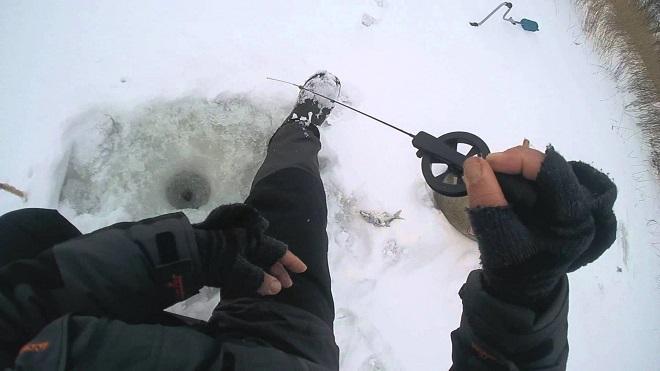
Nod
How to set up a reelless fishing rod? The nod in a reelless fishing rod for winter fishing is the main working element. A guard that is too soft will ruin the game, while a hard guard will create parasitic inertial vibrations. The nod is selected for each jig. How many different weights of jigs a fisherman uses means the same number of nods must be prepared and adjusted. In bait fishing, the entire length of the guard works and bends, while in reelless fishing, in most cases, the upper third is used. Nozzles with a fast action are more suitable for nozzles. Types of nods:
- Lavsan;
- Metal;
- From a plastic bottle;
- From X-ray film;
- Spring (swallow wing);
- Carbon fiber.
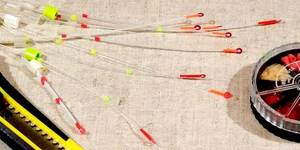
Previously, boar bristle nods were widely used. Nowadays lavsan and metal are in use. Setting up and selecting a nod in a rewinder is a separate big issue. Read more in the article about nods for rewinders. The nod is adjusted depending on the weight of the jig and the required game, depending on what kind of fish. Bream requires low-amplitude low-frequency vibrations, and perch requires high-frequency vibrations. Roach is somewhere in the middle. Each angler customizes his nods to suit his own specific game. In the no-kick version, the whip already in use requires careful attention. More often it is a coal tip from a summer fishing rod, selected according to its length and thickness.
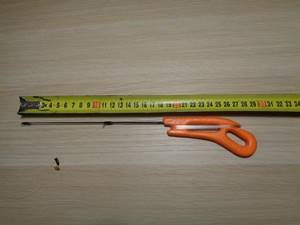
Flies and fly agarics
Recently, baitless jigs have been replenished with new plastic or silicone baits. Some winter flies migrated to fly fishing straight from fly fishing. The use of such reelless baits is no longer standard baitless fishing, but an emerging new direction. And this is understandable - some life-size products depict natural living insects, the food supply of fish. Amphipods, caddis flies, and mayflies, when executed well, are indistinguishable from a distance from live crustacean beetles.
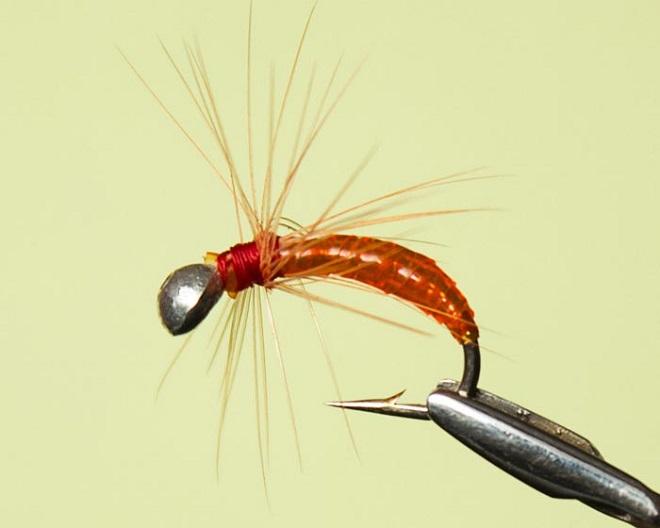
Front sight
Lesotka reelless jigs and Papuans jigs have a multi-jointed structure. They can be used immediately in a reelless fly, but they work better when equipped as heavy flies. It is convenient to wrap lurex, threads and all kinds of hair on the ribbed body, depicting natural aquatic organisms.
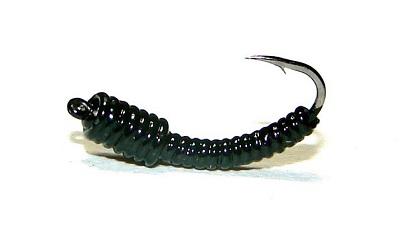
Lesotzka
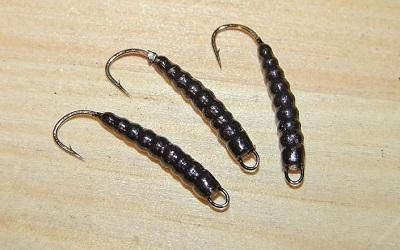
Papuan
One of the new products is a silicone lure of a goose dragonfly larva - completely identical in appearance to a natural insect. Suspension - in the middle of the back. Large nozzles can be used as a balancer; the smallest ones are perfect for nozzle-free experiments. A variety of such deceptions are silicone fingerlings.
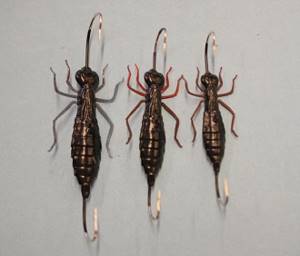
Goose larva
Heavy flies (fly jigs) are used as standard, only the action required is no longer high-frequency, reelless, but reminiscent of the natural movements of the corresponding insects. More often these are dotted lines - monotonous stretching with pauses (2-5 cm). Lightweight flies or silicone minnows are used for suspension in tandem with a rewinder.
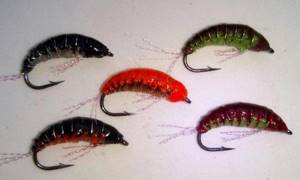
Amphipods

Fly agaric
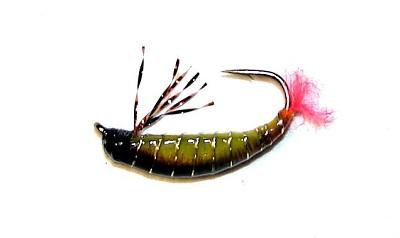
Mayfly
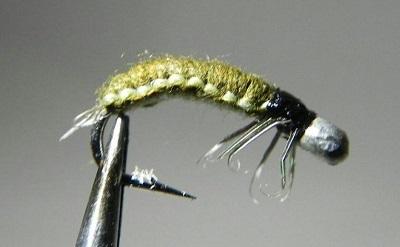
Caddisfly
Some practical tips
Despite dozens of techniques for playing jigs, experience with this bait comes only through practice. Each time you need to select the amplitude of oscillations, as well as the speed of vertical and horizontal movement for a specific body of water, as well as a certain type of fish.
Fishermen with extensive experience in winter fishing give the following general recommendations:
- On the first ice, the jig must be moved very quickly and often vertically. This is explained by the increased activity of fish during the first ice.
- In the middle of winter, the fish becomes lethargic, so the amplitude of oscillations should be reduced, and the bait should be moved vertically very slowly.
- Closer to spring, the rise and fall of the jig should be very fast, the number of vibrations should be minimal, and the amplitude should be maximum.
Let the ice be strong and the catch rich!
(
20 ratings, average: 3.80 out of 5)

Margarita Pavlova
I am writing in the sections “Household Appliances” and “For Children”.
Internet journalist, copywriter with 8 years of experience and simply a creative person. I create interesting texts, immersing myself in every topic. I have a higher pedagogical education, I like order in everything, and I am interested in new fashionable devices.
Decorations
No one knows what an ideal mothless machine looks like. Finding colors, shapes and sizes is a constant experiment. Today it works, tomorrow it won’t. The same jigs for baitless fishing can be equipped with different decorations - and this increases the variety of these baits significantly. Decoration options:
- Mormyshki columns with a ball, cube or other single large object (nail balls and nail cubes).
- Jigs with hanging beads.
- Cambrides, elastic bands, plastic circles, pieces of foam rubber on a hook.
- Threads, Lurex and other fly fishing tricks
- Stickers, paint flecks, stripes and overall coloring.
- Jigs with a chain.
- Reelless baits without decorations (pure devils).
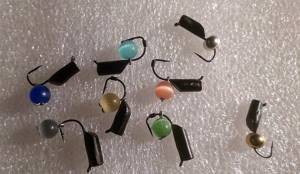
The color of the reelless jig itself is an experimental question. Traditionally, black and silver shades, as well as unpainted lead, are more often used. However, in some periods, bright, provocative colors of acid green, red, and yellow work better. Such reelless fish also have the right to hide in the fishing box - one day they will start fishing.
DIY mothless
Today, the products of some craftsmen are the envy of famous manufacturers specializing in the production of fishing lures. These are real works of art that can be shown at specialized exhibitions. Anyone can make a simple mothless machine. To do this, you will need only two elements - a hook and a lead pellet weight.
First you need to widen the cut of the pellet so much that the shank of the hook easily fits into it. Then everything is clear, insert the hook into the lead ball, squeeze it tightly and heat it to give the body the shape of a drop. At this stage, you must act carefully; you must not overheat the lead, otherwise it will simply drain. The jig “cast” in this way is sanded with fine sandpaper, painted in the desired color and decorated with cambrics. The mothless is ready! Whether she catches or not depends on the fisherman himself. As they say, everything is in his hands. The main thing is to believe in your creation, and then everything will work out.
Manufacturers
Initially, reelless baits were made independently, either completely or by modifying bait baits. However, more and more ready-made reelless baits are appearing on sale, intended purely for fishing without bait.
- Ivanovo jigs (Mast Iv - Masters of Ivanovo).
- Vladimir jigs.
- Jigs Trick.
- Sanhar.
- Cape Verde.
- Bezmotilka Ukolova (mainly devils and Uralkas).
This is not a complete list. Often, catchy and unique versions of reelless baits are made by hand in small quantities. Such original works are more expensive, but they also show themselves appropriately on the pond. Making a reelless reel at home using simple options will not be difficult for the average fisherman. Some reelless machines are assembled literally on the knee, without mold filling or tungsten turning. Tin or lead blanks can be made at home without much effort.
Features of the game technique
At the beginning of the article it was already said that the determining factor for success when fishing with a reelless jig is the correct game. Each of the described types requires the right approach to the game. This is described in more detail on our website in articles about specific rewinderless machines and in a general publication about nozzleless equipment (the very first link). However, you shouldn’t look for the treasured game in the little things for each bait option in theory - they simply don’t exist. It is important to know the basic features and remember the general law - a monotonous game without failures. Details come with experience, and each hacker has his own, unique nuances of the game.
Subscribe to the channel:
My YouTube channel RYBAFAN on fishing:
We're OK
Features and nuances of fishing with a reelless reel
Compared to baited analogues, fishing with reelless reels has the following features:
- At the hole, the fisherman begins to drill from the shore and towards the center of the reservoir in large increments of 8-10 meters.
- If a bite occurs in a hole or a fish is caught, the area around it is drilled in 4 directions in a “cross” pattern, making 4 more holes perpendicular to it;
- During the fishing process, the angler experiments, very often changing baits and playing techniques. This is necessary in order to select the most suitable reelless reel for specific fishing conditions and play with it.
- Promising holes in which fish were caught, but the bite then stopped, are fed with a pinch of bloodworms, marked with a twig or reed stalk, in order to return after a while and re-fish them.
